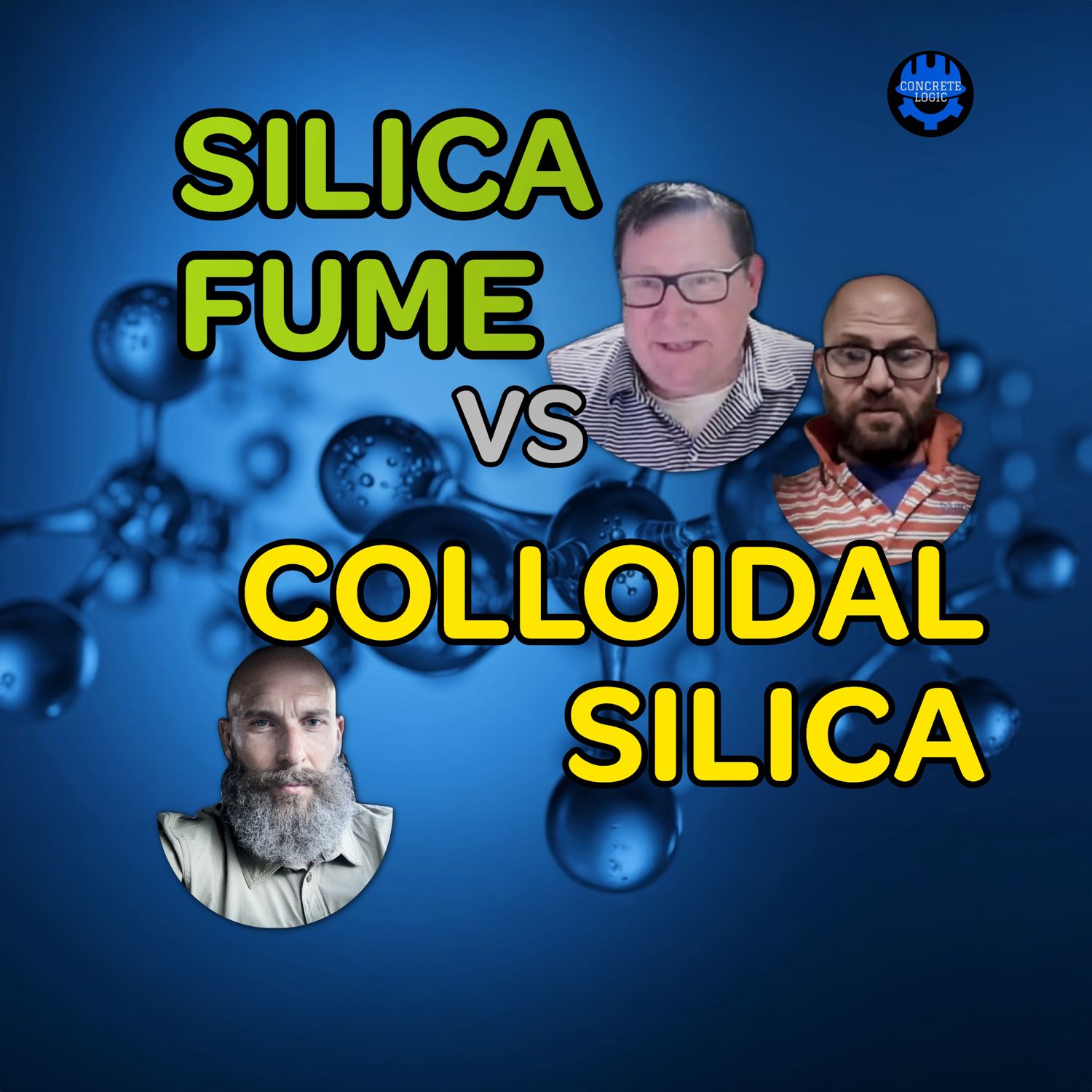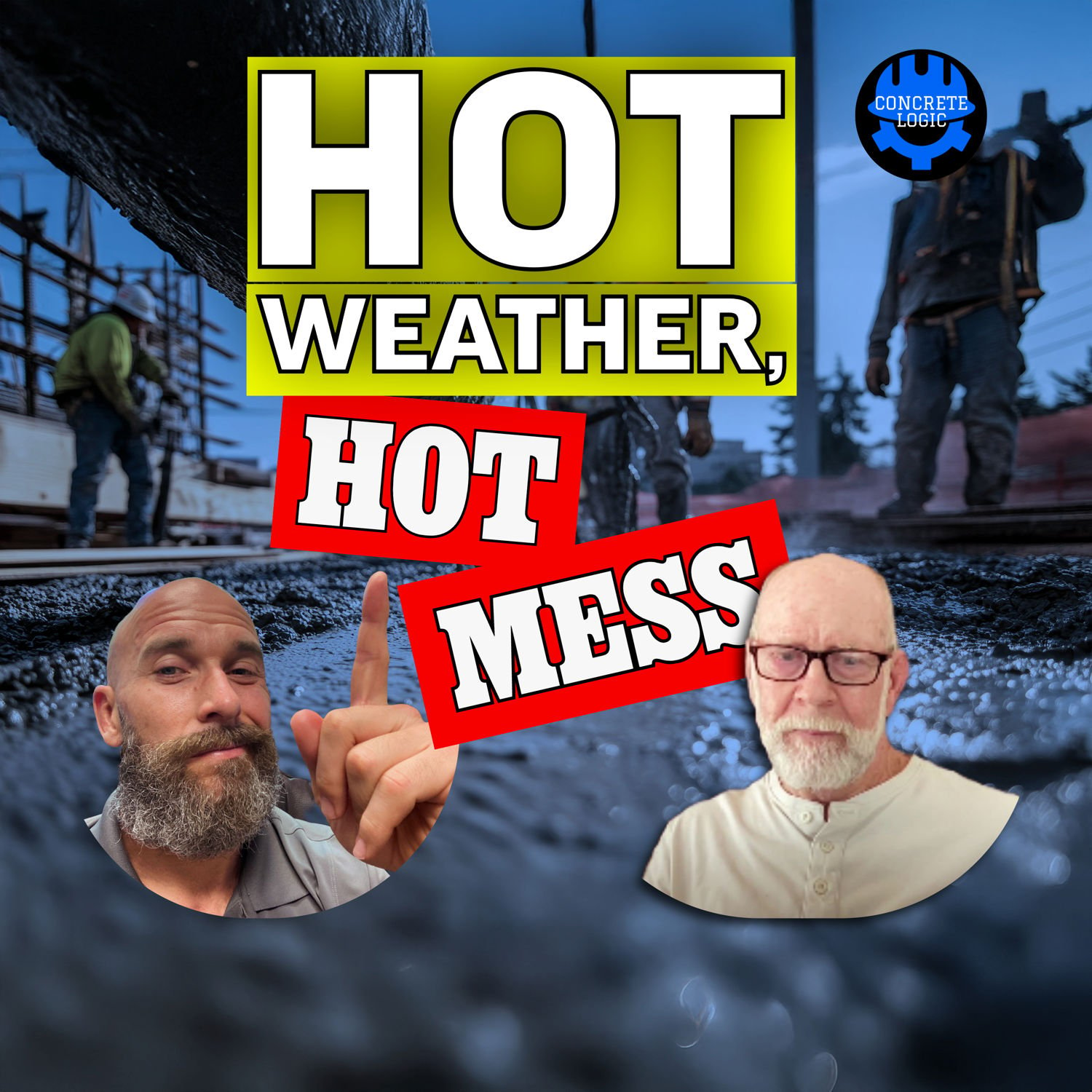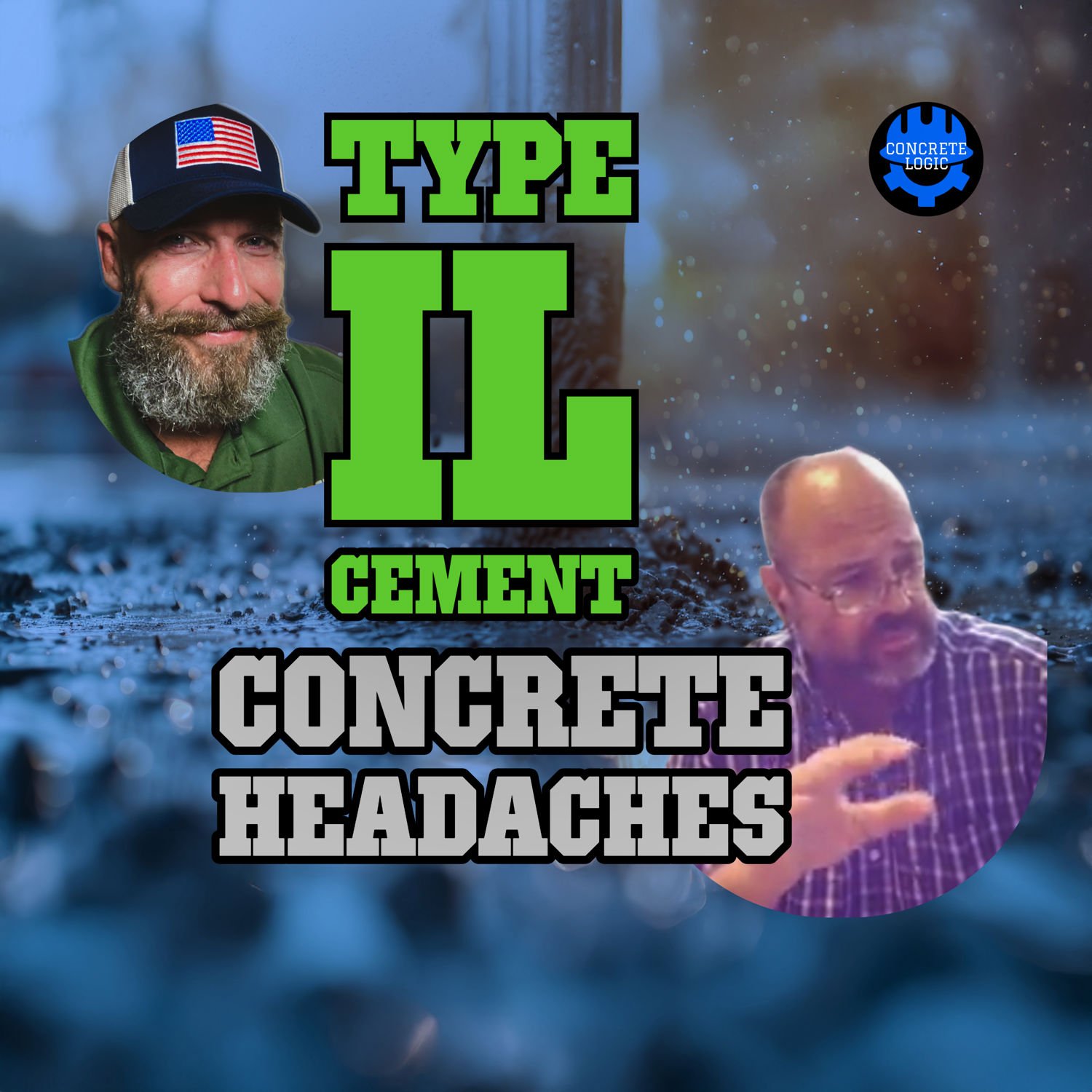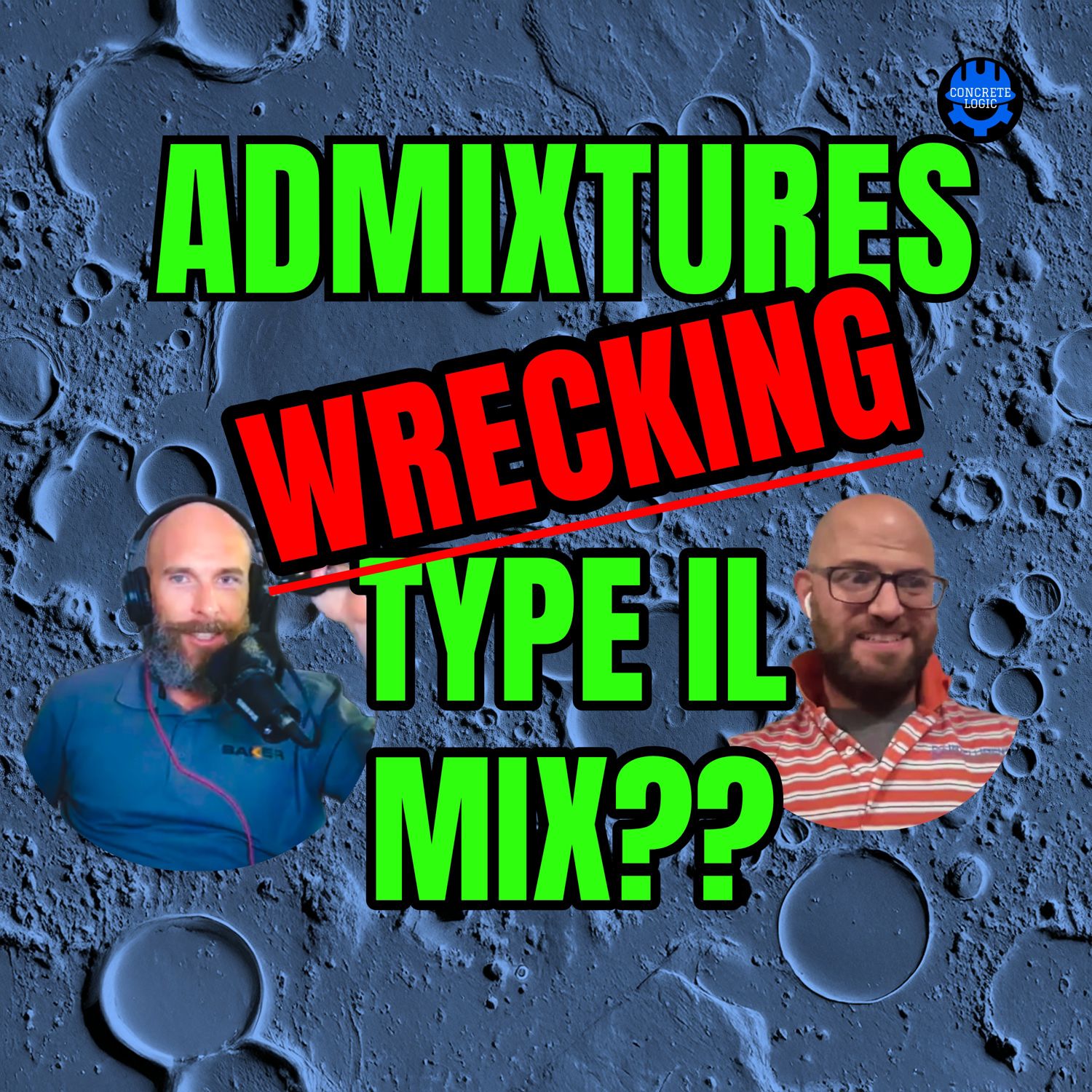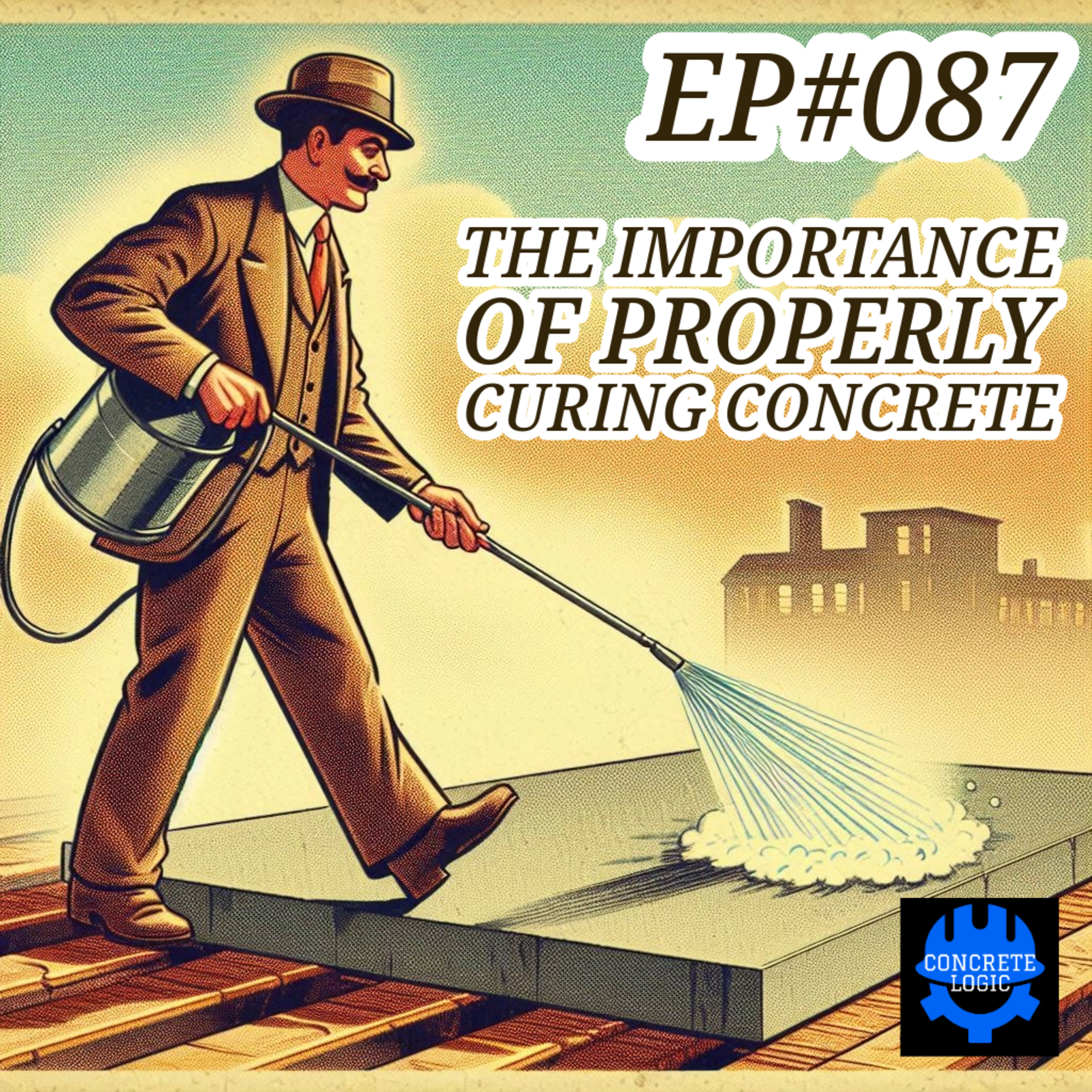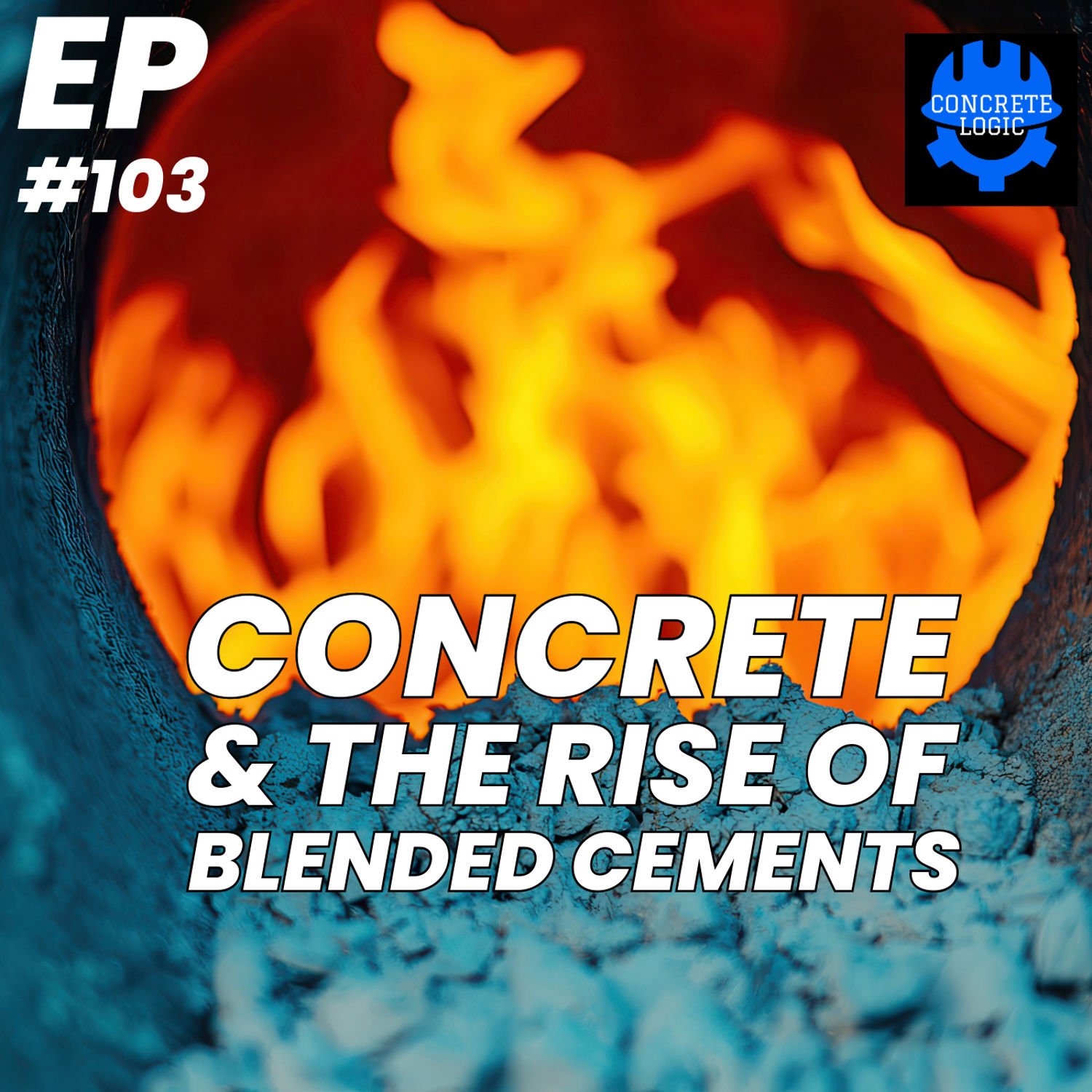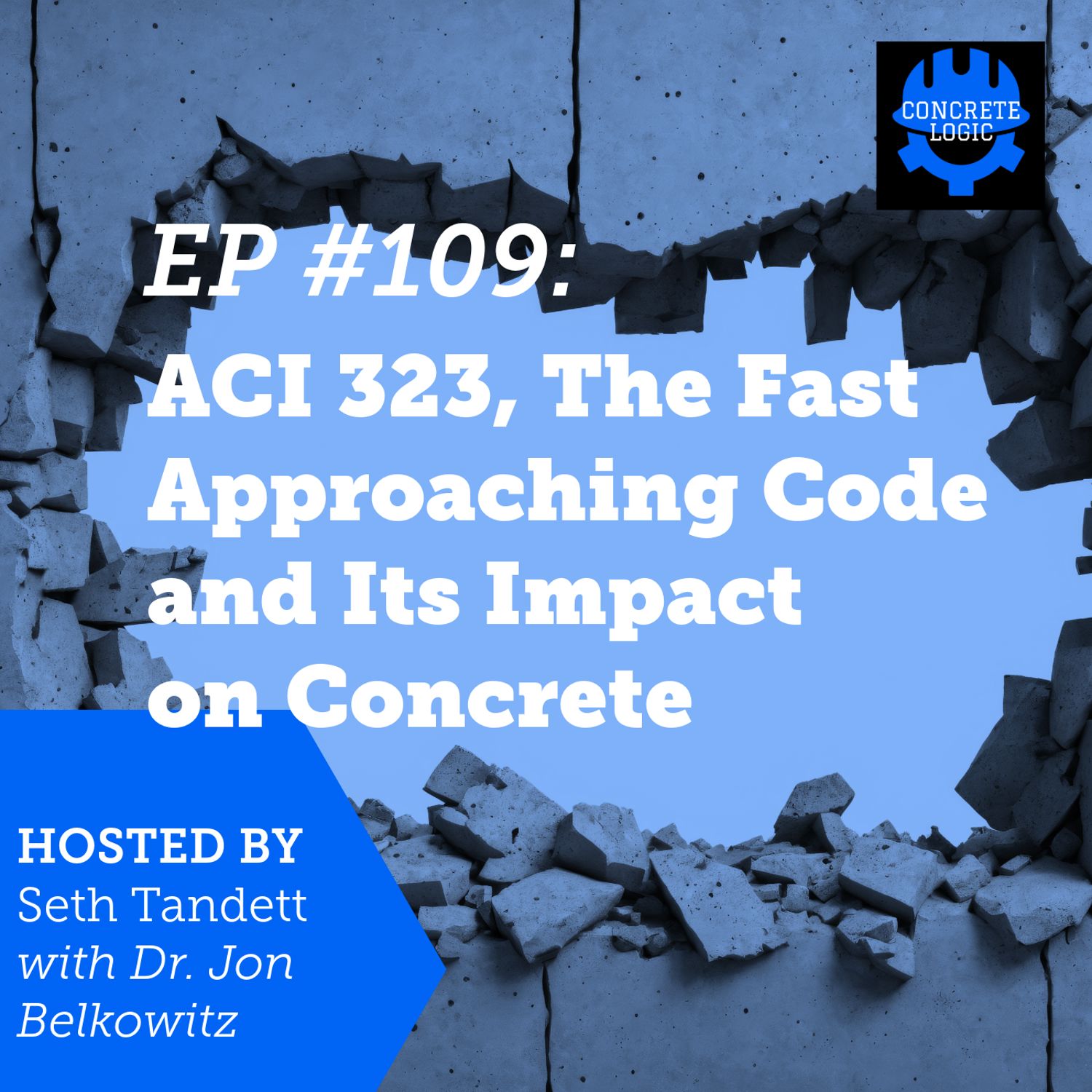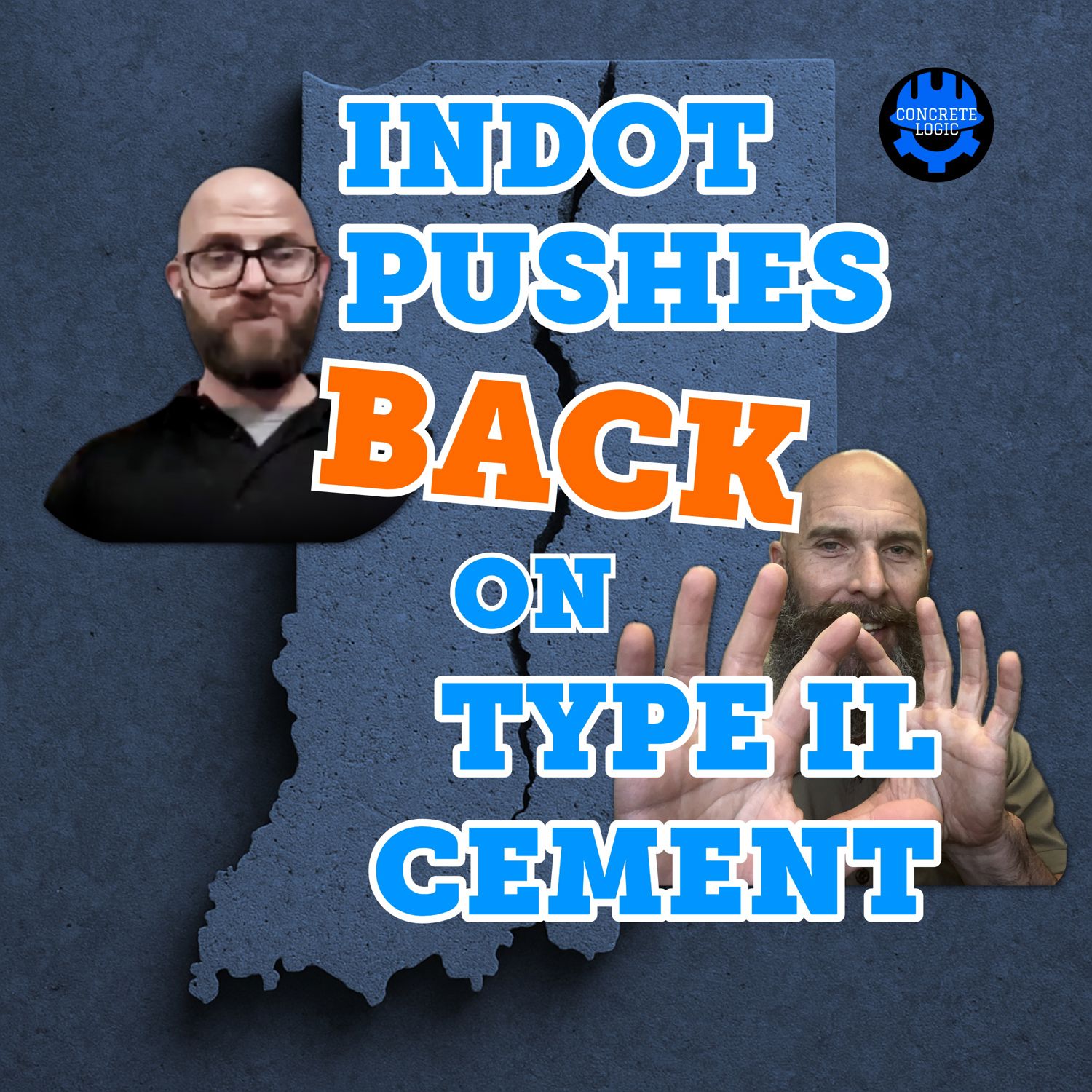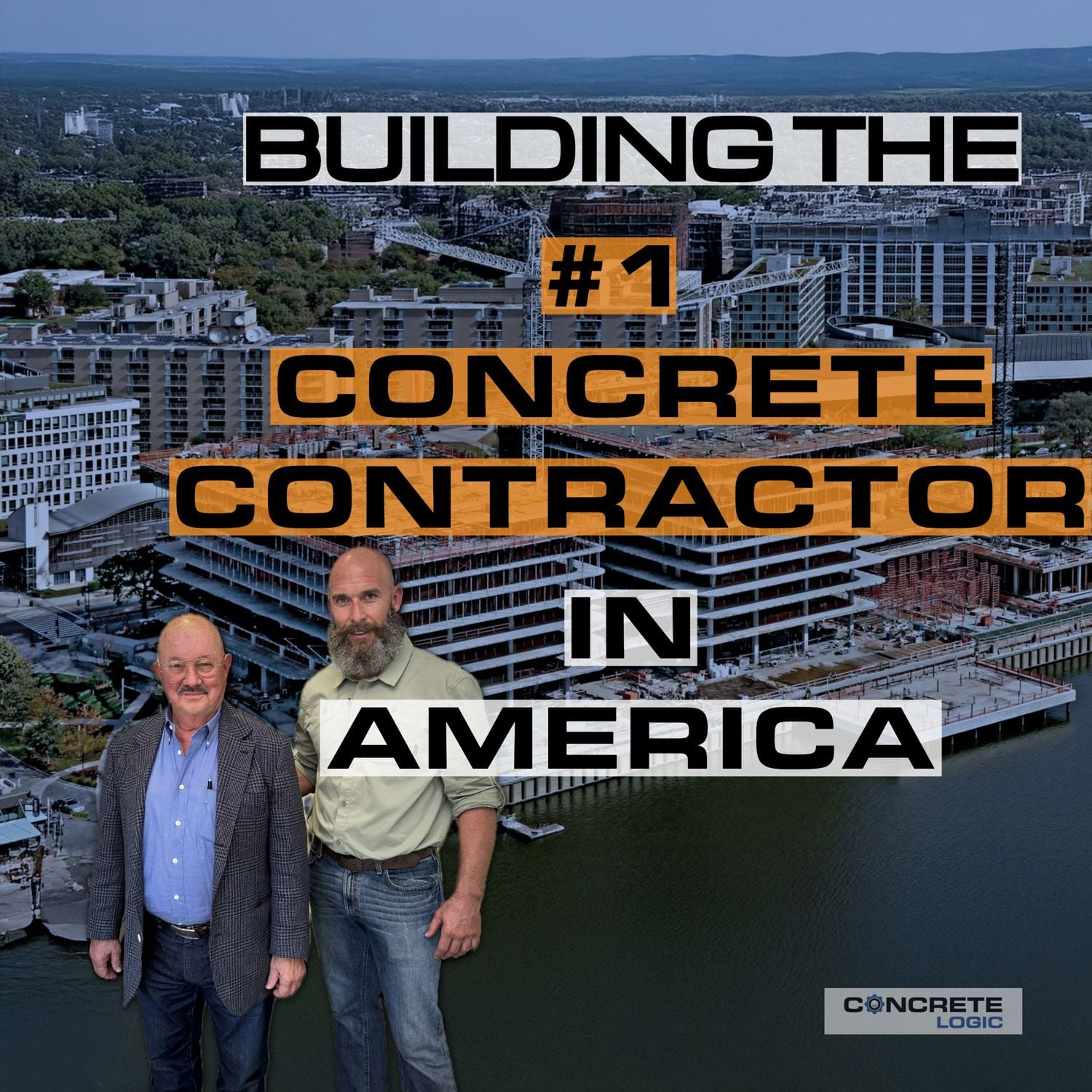EP #136: Concrete Profit — 7 Ways Ready-Mix Producers Can Stop Losing Money
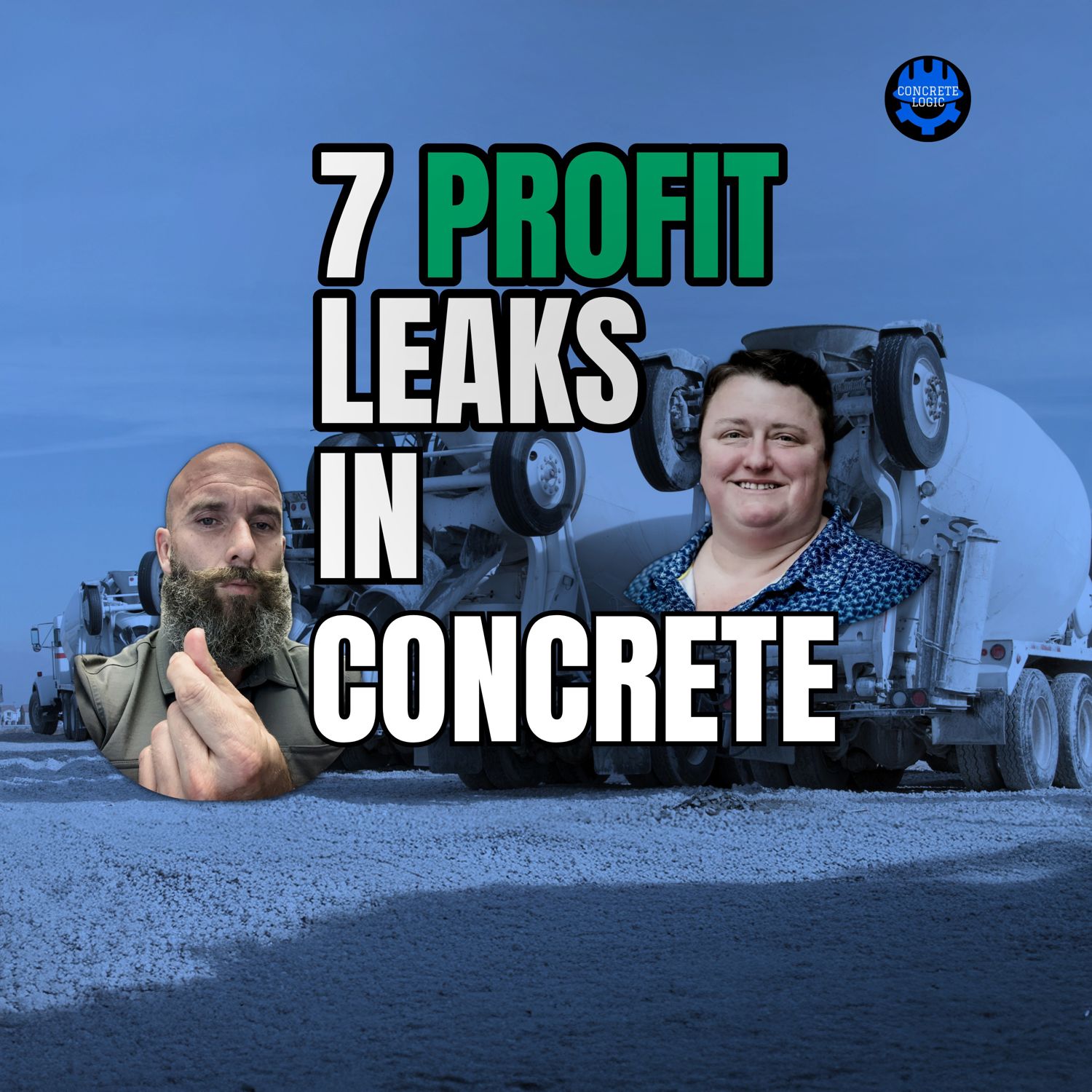
What if the problem isn’t your concrete, but how you run your business?
In this episode of the Concrete Logic Podcast, Seth Tandett talks with Tamson Omps, Director of Operations at Thomas Concrete, about how ready-mix producers can finally take control of their margins. Tamson lays out the seven areas that make or break profitability in the ready-mix business—from equipment maintenance and driver retention to scheduling and waste management.
Whether you manage a single plant or oversee a regional operation, this episode gives you a practical, no-nonsense look at what’s actually driving your profits (and losses) today.
What You’ll Learn
• Why does Tamson say “we don’t sell concrete—we sell truck space”?
• What simple maintenance strategy can save thousands in downtime?
• How can ready-mix companies cut driver turnover by focusing on the right incentives?
• What’s the real cost of a truck sitting on the jobsite?
• How does batching setup and admixture sequencing impact load times and profit?
• What can schedulers do to eliminate wasted hours in the yard?
• How can waste and return concrete be turned into an extra revenue stream?
Chapters
00:00 – Introduction: The Profitability Puzzle in Ready-Mix
01:19 – Shifting Perspective: Concrete as a Service, Not a Product
03:25 – Low Hanging Fruit: Equipment Maintenance
04:36 – People Matter: Keeping Delivery Pros on the Team
08:20 – Truck Turnaround: The Real KPI That Matters
11:02 – Load Times and Plant Flow: Admixtures, Sequencing, and Efficiency
18:16 – Scheduling for Success: Managing Peak Demand
22:54 – Waste Management: Turning Returns into Revenue
Guest Info
Tamson Omps
Director of Operations, Thomas Concrete
Email: tamson.omps@thomasconcrete.com
LinkedIn: https://www.linkedin.com/in/tamson-omps-mba/
Company: Thomas Concrete – https://www.thomasconcrete.com
Concrete Logic Academy
Earn PDHs the easy way. Listen to podcast episodes, complete a short quiz, and get professional development hours with proper documentation.
Start your free trial: https://www.concretelogicacademy.com
Support the Podcast
This show runs on a Value-for-Value model. If you got value from this episode, consider supporting us:
https://www.concretelogicpodcast.com/donate
Support the show while gearing up with KUIU premium outdoor gear—what Seth wears both on the hunt and on the job. Shop through this link at no extra cost: https://www.concretelogicpodcast.com/KUIU
Want help with media services like podcasting or YouTube for your concrete company? Reach out to Seth at seth@concretelogicpodcast.com.
Credits
Producers: Jodi Tandett and Concrete Logic Media
Music by Mike Dunton – https://www.mdunton.com
Connectivity
Host: Seth Tandett – Concrete Visionary & Business Development Manager at Baker Construction
LinkedIn: https://www.linkedin.com/in/sethtandett
YouTube: https://www.youtube.com/@concretelogicpodcast
Website: https://www.concretelogicpodcast.com
Don’t forget to like, subscribe, comment, and share. Let’s keep it concrete.
Seth Tandett (00:00)
And welcome to another episode of the Concrete Logic podcast. Today I have Tamson Omps Director of Operations Services with Thomas Concrete. She's going to share some insight on increasing profitability for ReadyMix company, which we've never talked about this before. And I know a lot of producers out there listening to this show. think that is majority of my audience.
So Tamson do you want to share a little bit more about yourself before we get started?
Tamson Omps (00:31)
Yeah, yeah, Director of Operation Services here at Thomas Concrete. We cover the Carolinas and Georgia. Prior to that, majority of my career has been in technical services, both here in the Southeast and a good bit of time in the Northwest in the Seattle, Western Washington market. And then just got to my pitch for the Blue Raiders, MTSU.
Seth Tandett (00:51)
there you go.
Yeah. I asked Tamson before we hit record, was like, you're middle Tennessee. You've been on at 10 gallons. And she's like, no, I haven't. was very disappointed, boys. You're to have to reach out to her. But I got her first. So there. All right. Well, so where's a good place to start with this? Where should we start with profitability?
Tamson Omps (01:05)
Not yet.
Yeah, sure. I think my favorite lesson learned so far in the industry is we don't actually sell concrete. I know that might be shocking, but we don't. Anymore than FedEx sells boxes, right? We have one product that we put in our trucks, but at the end of the day, we're a trucking company. We fill up our truck.
We empty that truck as fast as we can and then we fill it up again. And we keep doing that until we run out of hours. And that shift in thinking is what is able to drive profitability for ReadyMix producers. If we stop thinking about our product as concrete and start thinking about it as trucking, we start making better decisions in how we're utilizing that equipment, those assets, those hours.
Seth Tandett (02:04)
Yeah. Actually,
for folks that have listened to this podcast before, you're not the first person that's told us that. Dr. Sazy has been on the show and that's his thing. He says the same thing. And then I think Dr. Belkowitz steals that from him and says that as well while he's on here.
Tamson Omps (02:21)
Yeah,
I got that one from a sales manager probably almost 20 years ago in Seattle. And we were giving a customer presentation and that's what he left with was, by the way, we don't sell concrete. I'm not a sales manager for a concrete company. I sell space in my truck. I just put concrete in that space.
Seth Tandett (02:37)
Yeah. So was that
the turning point where you started looking at things a lot differently?
Tamson Omps (02:43)
Yeah, that one always stuck with me. I I stayed in tech services for quite a while, so I was on the periphery of needing that information. But then once I moved into operations, it became very real, right? Everything from managing our preventative maintenance programs on not just the plant, but our trucks, prioritizing that ahead of shipping load, right? Sometimes that's a hard lesson to learn, right? We can decide to do maintenance on a truck or the truck can decide
for us that it needs maintenance, right? But if we don't schedule it, then it's going to impact our customers, going to impact our day. And at the end of the day, if we don't have a truck, we're not selling product. Definitely. Super.
Seth Tandett (03:21)
Yeah. So is that what like low hanging fruit for a producer?
Tamson Omps (03:25)
Yeah, super low hanging fruit, Preventative maintenance on your plant, we tend to look at that asset because these are millions of dollars of assets, right? Putting up a new plant is a three million dollar investment out the gate, right? So when you're thinking about the plant, you're really thinking about how do I make sure I maintain this very valuable asset? And when we get to our trucks,
It tends to be a we'll get to it when we can get to it, right? We're going to be in compliance with DOT rules, but DOT rules don't make sure that that truck stays on the road on a reliable amount of time. your truck uptime becomes a vital importance. And scheduling that maintenance becomes critical to your successful operation.
Seth Tandett (04:03)
Yeah. So what else do you go look at if you start with the equipment? What's the next thing?
Tamson Omps (04:11)
So equipment, first and foremost, people is your next, right? Target turnover rate in the industry for CDPs, for concrete delivery professionals is 30%. So every year we're losing a third of our staff, a third of those professionals. If you can start cutting that number, you're generating profit, right? We know in that first 13 months is our highest risk for any concrete driver.
Driving a ready-mix truck is not inherently dangerous, but it is unforgiving. And we spend a lot of time training, not just on the safety side of things to make sure we're safely operating that truck, putting it out in the public with our families, but that we're also delivering a quality product and delivering good customer service when we get on site, right? That is our highest level touch point are those drivers. So losing a third of them every year is pretty critical. Driving that number down.
really focusing on taking care of our drivers is the the next best thing after taking care of our women.
Seth Tandett (05:10)
Yeah, that's crazy. And it's
hard. It's hard enough to get them right.
Tamson Omps (05:14)
Yeah, and trucking is unfortunately a little bit of a dying industry. There's not a lot of appetite out there for folks to get into trucking. So being creative on that marketing as well, right? A lot of the a lot of the downside of getting a CDL is thinking that you're going to be over the road and away from your family and overnighting and having that grind, right? But our best sales pitch is you're home every night. We might not know what time we're getting home, but you're home every night and you're going to deliver local.
So making sure you're leveraging that when you're recruiting. Set realistic expectations. The kind of worst part of the job for a concrete driver is you're never sure what time you're starting and you're really never sure what time you're going to get off, but you're going to get good hours and it's going to be pretty stable work and you're always going to be home.
For folks that are trying to figure it out, trying to figure out what that next step in their career coming out of school is, it's a good option, right? High school don't necessarily want to go and get a degree, don't necessarily know what trade they want to go into. Getting a CDL is a...
a great path, even if that's not the permanent path. A lot of our managers came up as drivers and then eventually working in the plant and coming up through that management path. So really good opportunity for young folks getting into the industry.
Seth Tandett (06:31)
Yeah. Believe
it or not episode 101, we interviewed Abigail Olson and she's, uh, she's, she's only like 24 at the time of the podcast we recorded. And she talked about that same experience and what drew her to be a concrete driver. And she wants, she, she told, uh, folks, uh, in high school and she went to a very, uh, uh, prestigious high school here in Richmond.
And she told them she wanted to be a truck driver and she thought they thought she was crazy. And so she wanted to do over the road was what she wanted to do. And she found out there were limitations based on age of what type of jobs you can do. And that's how she fell into driving the concrete truck. So it's a really cool story. Yeah, you all should check it out, especially if you're interested into it. But yeah, same thing. It's not like your end all, you know, career.
Tamson Omps (07:05)
you
Yeah.
Seth Tandett (07:28)
decision, right? You're taking steps to get to a point, you know, where you can get if you want to be in management. Some people don't like managing people.
Tamson Omps (07:37)
Yeah, yeah, absolutely.
I'd say half of our mechanics have their CDLs. We've got maintenance supervisors or maintenance folks that started out in a truck and they just they get into the industry and then see the possibilities that are there and having that CDL. It's a guaranteed job, whether it's in concrete or somewhere else. That is a guaranteed job any day of the week. So start there and then the rest will just fall into place. You'll figure it out with a few years under your belt.
Seth Tandett (08:02)
Yeah, or those folks out there looking at retiring. That's a good retirement gig, I would think. Yeah. All right, let's stay on task. I'm sorry, I got us off task. So we take care of our equipment. We take care of our people. What's the next thing?
Tamson Omps (08:09)
yeah, yeah, absolutely, absolutely. Yeah, that's great, that's great.
turn in those trucks quickly, right? So we've got good operating trucks, we've got good operators, those operators are selling to our customers every day, because that's our highest touch point. And so now how do we get that truck out and back? How do we get it hopefully full on the way there, and then return to us as quickly as possible? So...
few methodologies there and depending on the type of concrete that contractors are doing, they'll see that in the pricing model, right? There are some jobs that just take a while. If you think of CMU or Augercast, there's a lot of wait time on that truck that's every minute that it's waiting, it's losing money, right? So being able to recoup that somehow either through diversifying in commercial work, residential work, and diversifying that type of work. So it kind of all meets in the middle or doing some
pricing variation based on how long that truck is going to be on a job site. And I'd say there are probably some ready-mix producers that take it even a step further and not just the type of project but the customer that we're working with, right? And so the pricing is impacted based on how efficient you as a customer.
use our trucks. Not everybody does that, not even here at Thomas. It isn't necessarily a given, but it is something that we have to take into consideration as ready mix producers. How quickly are our trucks going to be used? How efficiently are they going to be used? Are we running a lot of short loads? Are we getting a lot of wait time when we get to the job site? So we're waiting 20-30 minutes before we can start pouring. Those are minutes that add up into pretty big dollars.
Across the board, that truck and driver are costing us $1.25, $1.50 a minute, depending on where we are in the US. And that's here in the Southeast. You get up into the West Coast in the Northeast, it goes up from there. So these are big dollars every time we're sitting on a job site.
Seth Tandett (10:10)
Yeah.
Yeah, so when concrete contractors are hollering at y'all to get on the site and get off the site, you're on the same, you're on, you have the same goal. You don't want to hang out.
Tamson Omps (10:22)
we're on the same page. Yeah, we're on the same page. Yeah.
Yeah, we don't want to hang out. That truck is not making any profit, not making any money if it's not full on delivering something.
Seth Tandett (10:34)
Yeah. All right. Yeah, I always I ask her guys, I'm on the business development side and not I used to be on ops. I like giving the guys a hard time here in the office sometimes like we pouring concrete today and hopefully answered yes. And I say they say no, I was like, we're not making any money today.
Tamson Omps (10:51)
Yeah, yeah, it's just the way it goes. We pour
concrete, the building goes up, right? So, yeah.
Seth Tandett (10:55)
Yeah. All
right. So we did equipment, people, and turning trucks. What's the next one?
Tamson Omps (11:02)
Yeah, from there we start getting into kind of the nitty gritty, right? How quickly are we loading those trucks? Are we costing ourselves minutes?
right? How quickly are we washing those trucks and getting them turned back in the line? What kind of wait time are we giving ourselves? How efficient are we running our schedules? So we'll start with load times. That load out piece, you can have plants that you've got from ticket to load leaving the yard in 10 minutes or less. And that's perfect. That's ideal. That gives you time to get the truck loaded, safely washed down, quality checked, and out the door. And then you've got
And I'm speaking just here, Thomas, right? And I think this will apply across the board. Any ready mix producer that's really critically looking at themselves, they'll be able to say the same thing. You'll have other plants that that average load to leave time, that ticket to leave time runs in that 15 to 20 minutes. Those are minutes you're not gonna get back on that truck, right? Whether it's impacting, and hopefully not impacting the customer schedule as well, right? It could be.
But we know when we're not running efficiently, those are dollars that we're losing. And if that's every load that's running 10 minutes over what you needed to run, that's 10 bucks out the gate, 15 bucks out the gate that you've lost on that load. You'll never get it back. So making sure we're...
A, training our drivers to get out the door quickly, safely, right? Make sure we're running clean trucks. We don't need to be popping windshields, making people mad, going down with our giant rolling billboard. But let's do that efficiently. And whether that's through coaching and training or whether that's through tools, there are a few wash down systems out there that the truck pulls through. It washes the truck for you, driver exits the yard and that's super efficient.
those large metro areas, I highly recommend finding something like that because the minutes that you save on that truck, it will pay for itself in no time. The payback in some cases for us has been less than a year on those systems. So highly recommend that gets the trucks out the door.
Back up to the plant side, right? There's a lot of things that we can do on sequencing, how we set up our materials, the order of operations on those materials when they're batching in that can speed that load time. And probably gonna make a few tech services folks mad, because I used to be on that side and I'd get mad when I'd hear that. But we've gotten really crazy with admixtures and admixtures have added time to that load.
admixtures have their time and place and they're necessary in a lot of scenarios, but anytime that we can go with the strategy of less is more, it certainly improves efficiency on that concrete truck side that load outside.
Seth Tandett (13:38)
Yeah, that's interesting. I haven't heard anyone bring up that point.
Tamson Omps (13:43)
Yeah, operations folks will hammer you with it. Especially, specifically the the high range water reducers out there. Some of them can get are a little slower to build legs and get fluid. So you're waiting on that mixed time dry batch plant. You're still waiting on the truck and a wet batch plant. You're waiting for it to get fluid enough to come out of your plant, right? So you've literally bottom bottlenecked the entire yard by bottlenecking.
that central mixed plant. And unfortunately, more often than not, central mixed plants tend to be in metro areas and they're running some high spec concrete. it's just the nature of the work that those plants do. We just have to be judicious in applying that.
that admixture first kind of mentality on the quality side because sometimes what we make up in maybe a cost efficiency on materials we lose on the back end operationally. So just finding that balance is the important part.
Seth Tandett (14:37)
that's interesting. I was going to ask you which is better, the dry batch or the central batch as far as load time.
Tamson Omps (14:46)
gosh, okay, it depends on how you look at it and what you're running, right? On the plant time, you're able to batch tech. It's a hard one to answer because it depends on how efficient you are. Load your dry batches set up to.
Seth Tandett (14:49)
OK.
Tamson Omps (14:59)
load the materials into the truck. If you can get your pitch right on your loadout so that you're feeding materials using gravity and not just the blades in the truck. So it's accepting material faster. You can have dry batches that run faster than wet batches, especially in reference to that admixture conversation. Now traditionally a wet batch is going to run faster.
unless you slow it down with the materials that you're putting through it. So if you're running high strength all day, it's going to be really hard for a wet batch to keep up with a dry batch. If you're running 3,000 residential all day, that wet batch is going to just smoke your dry batch. And it also a lot goes into how you've got your material feed set up. There's a lot of components that feed into that. But really what you're asking yourself is do you want your trucks being the bottleneck or do you want your plant to be the bottleneck?
If can get your trucks off the yard quickly, then you make up that time having a wet batch. If you can't, go with a dry batch. If you're running a wet batch that's got 12 minute load to leave times, you're gonna lose that battle. It's gonna be more expensive maintaining the wet batch than what you're trying to make up for in loads leaving.
Seth Tandett (16:03)
Is that why wet batch is more popular in metro areas? You mentioned that.
Tamson Omps (16:08)
Yeah, that and quality. So for a wet batch, you can shrink mix. We don't have to, there's the misnomer that with wet batches, we're fully mixing in that drum. You can shrink mix, meaning that you mix for just long enough to get the material fluid enough to exit the drum and enter the truck. And then the truck finishes that mixing in transit or at the wash rack, right? And if you're doing that, you're able to get those load out times down to really total mix time in the central mix place.
90 seconds, some mix is even shorter. If you're meeting quality standards at that point, you can go a little bit shorter. Those high strength mixes are where you bottle up. You might end up mixing for two and a half minutes. So you're not loading another truck until that two and a half minutes is expired and just mixing time, right? So that's where you get into that downside with those wet patches. But I would say production rate drives a lot of the location as far as metro areas with wet patch. And then a little bit of the quality demand.
You can make quality concrete out of a dry batch plant. No doubt about that. But your eyes on that quality potentially change every load with every driver. Whereas with a wet batch plant, it's the same set of eyes that are looking at the consistency of that concrete every time. So, putting my tech services hat on, if I'm running a lot of high strength, high spec concrete, I prefer a wet batch because you have that
limit on variability, right? And that's the most critical thing for us on the QC side is the materials are going to do what they're going to do, right? We know based in the lab, the maximum performance and then everything that we do after that, every change that we make after that in production is what impacts our quality. yeah, did I do a good enough job fence sitting so that I'm not going to get nasty grams from folks that are all dry batch or all wet batch?
Because know even internally here, you would get two different answers depending on which ops manager you ask.
Seth Tandett (17:48)
Yeah.
Yeah,
yeah, I've seen the wet batch spec for like airport paving. Yes, that's the only time I've seen it like required. But yeah, that's great insight. So we talked about equipment, people, turning trucks, loading trucks, plant set up. What's the next one?
Tamson Omps (18:01)
yeah.
Yeah, be efficient with your schedule. And sometimes that's out of our control, right? We don't like to have those peaks and valleys in our schedule. That's truck sitting. we get, we're really popular at 7 a.m. Lots of people like concrete at 7 a.m. And that's a little variable based on region. There's some regions due to heat that need to go a lot earlier than that.
But we have our peak start time that everybody wants. And then we have our peak afternoon time that everybody wants. And it's that in the middle time that we have to be creative on how we fill in. So we'd like to have that smooth line on our production schedule through the day as much as possible. And sometimes we need to get creative in how we're taking those orders, where we're taking those orders. We're removing our equipment around to make sure that we are avoiding those dead times midday.
you
Also on scheduling, when we're done for the day, we have a bad habit of maybe holding trucks a little longer than we need to just in case somebody calls back, right? Making sure we're communicating with our customers, understanding what they are really going to need at the end of the day, and then getting those trucks off the clock, right, as quickly as possible. Hold what you need to, but if you don't absolutely need that truck, having it there for a safety factor is costing you money. In the morning, you'll see folks
that'll schedule block schedules, so 15 minute or 30 minute time frames. If you can get your operation down and controllable to where you're scheduling to the, say, two minute.
variation. So literally your drivers are told to come in at 6.59 right 7.01 and get them at that level. If you know that your loadout is two minutes and you can cycle those trucks in two minutes or if it's five minutes whatever that cycle time on loading your plant that's what you should be staggering your start times for your CDPs. It's hard because things happen. I woke up late, I got a flat tire, my kid's sick right it's very difficult to not build an insurance in the start of your day.
because that first round we should never be late. That should be a golden rule of concrete. We're gonna be late on somebody today, guaranteed. Make sure it's not the first round because that's the only round we control.
So those are the harder ones to drill into because some of them get lost in the minutiae, some get lost in a safety factor, right? Customer first, make sure that our customers are getting the quality product that they're asking for at the time that they're asking for it. And achieving that goal means that we have to build in a little inefficiency for our schedule. finding the opportunities there, as small as they may be, will add up over time.
Seth Tandett (20:43)
Yeah.
Well, is this a time to ask what y'all do on weather days?
Tamson Omps (20:48)
do we have to have weather days?
It was such a novel thing for me coming down from the Pacific Northwest, right? And then hearing the term rain day, ⁓ like we had a few snow days in my time in Seattle because it's Seattle and they don't do snow. It never snows there. But I got down here and it was rain day and my CEO at the time said, hey, what did you guys do about rain days? was like, you know, a customer ask me that one time and said, we don't have
Seth Tandett (20:50)
I mean, we.
Yeah.
Right.
Tamson Omps (21:17)
those here. You pour concrete.
I'm not sure how to handle a rain day. Down here, we definitely have rain days. And I still struggle with the idea a little bit that we can't find an opportunity to pour concrete. There are some situations, right? You've just opened up all that red clay. You're not getting in there after a large rain in the morning. yeah, you know, we take as far as the operation side for us.
Seth Tandett (21:36)
Yeah
Tamson Omps (21:43)
We try and take the opportunity for plant maintenance where we can, right? If that's cleaning out tunnels, clearing off belts, whatever we can do safely at the plants, we'll call people in to do.
If it looks like it's gonna be like a morning rain effect, so we've kind of washed out the day, but the afternoon's gonna lighten up. We might bring people in to start working on trucks, getting some of that preventative maintenance, cleaning trucks, that sort of thing done. And then it's pretty common practice, at least in our markets, to have at least some guaranteed hours. And that's where we really start cutting into our margins, because we're not shipping concrete, but we're paying people. So that labor cost rolls in, whether we want it to or not, whether we can do it.
anything with it or not.
Seth Tandett (22:24)
Yeah, probably good idea to be looking ahead to find out who can guarantee a pour to on those days coming up. We got some rain days coming up. Yeah, coming up here in the area. So I'm sure our producers in the area are looking at who's definitely going to be pouring, who's pouring under a roof. Yeah. All right. That's great. All right. So again, equipment, people turning trucks, loading trucks, plant set up.
Tamson Omps (22:32)
Absolutely.
Yep, exactly, exactly.
Seth Tandett (22:52)
schedule efficiency. What else you got?
Tamson Omps (22:54)
Yeah,
and then we'll get last but not least, managing your waste, right?
We get this industry standard about 5 % of everything that we produce comes back to us in some way. Whether it's a quality loss, customer over order, whatever the reason is, there's probably dozens of reasons why concrete comes back to us. But about 5 % of everything that we produce comes back and we've got to get real creative on what we do with that. It's all market dependent on how easy or difficult it is to get rid of that. Seattle, we had a facility that was 0 %
waste, meaning we reused in some way, shape, form everything that came back to us. Because on that site, we didn't have the opportunity, there was no option to send that material anywhere else. It was going to cost us literally more than the concrete cost, more than what we were able to sell the concrete for. That's what we would have to pay to dispose of for, right?
It's pretty difficult to pass that cost reasonably onto a customer and be able to control it. So you get really creative. There's a lot of work that goes into having a zero waste concrete plant and often without that financial constraint, it's not a very viable option. But.
reusing that concrete in some way is always better than sending it off somewhere, even if it's free for you to dump. And there are markets where there are recycle yards that'll take the concrete for free, but it's not really free because it's still minutes on your truck, priority.
If your market allows it, is reselling quality concrete. Make sure you have a very diligent quality checklist and ASTM provides that for us. We have guidance on when it's okay to resell, when it's not. But if we can resell that concrete to somebody, that's the most cost effective thing for us to do and it gets into that zero waste realm. Next best thing for us to do, putting it into EcoBlocks, TomaBlocks here at Thomas.
At
some point you are going to either be able to make a bunker out of those, use them for a barrier or sell them to somebody to build a retaining wall or use as barriers, whatever it is, right? There's an opportunity to capture that revenue stream again.
There are folks that run reclaimers in the right scenarios, under the right financial stresses. Reclaimers are a good option, but they still produce a bit of waste in the slurry. So even if you can reuse the aggregates coming off of them, you gotta get pretty creative with the slurry that they produce. they are a good option if you can figure out what to do with that slurry and what to do with it. If you are anywhere near a cement plant, oftentimes they can re-burn that back in on their feed side.
So again, you create that zero waste and a little bit better cost benefit for you. We recycle almost all of the water that comes into our site, stormwater and processed water. So the water is less of an issue, but that slurry, if you don't have enough water to offset it, to be able to recycle it back into your concrete. Or some of the metro areas, the high spec concrete, it's just not practical from a quality standpoint to recycle that material. So you might have to find a way to be able to
treat and dispose of, but managing waste is a pretty major cause for us. The return concrete and water waste.
Seth Tandett (25:51)
Yeah.
Yeah, I knew a guy with a small plant around here. actually made... What did they make?
trying to remember what, but anyways, he had a small plant there and I remember he was saying that they had a bunch of Jersey barrier forms out there. So they would make Jersey barriers when they had trucks come back, things like that. So is that what an eco block is? It's just a.
Tamson Omps (26:12)
Yeah.
Yeah, you've seen eco blocks to guarantee it. They're like two and a half foot by two and a half foot and like, what is it, six feet long, like stackable retaining wall blocks is what they look like, right? They've got the little nubs on top so you can stack them like giant concrete Legos.
Seth Tandett (26:29)
Okay.
Yeah, who usually buys those off y'all?
Tamson Omps (26:37)
Man, it's a variety of uses. Retaining walls pretty significantly, but we even have party rental folks that'll buy them from us for counterweights for their tents. The uses are kind of endless. Anywhere that you need something big and heavy that nobody can move on their own, that's what they're good for.
Seth Tandett (26:46)
⁓ yeah.
Yeah,
that's cool. All right. So we had seven areas that we can work on to make our concrete producing business more profitable. So we had equipment, people, turning trucks, loading trucks, plant setup, schedule efficiency, and managing waste. we cover it all? no.
Tamson Omps (27:16)
Yeah.
no, I don't think we can cover it all. Yeah,
Seth Tandett (27:22)
just the ones that you want to share today.
Tamson Omps (27:22)
yeah, exactly, exactly.
Seth Tandett (27:26)
Yeah, this
was great. As a contractor, this stuff is fascinating to me to learn how y'all operate and kind of learn behind the scenes. I really appreciate you coming on the show today. It was great.
Tamson Omps (27:41)
Yeah,
I appreciate you having me. Thank you.
Seth Tandett (27:43)
Yeah. So
everyone, if you enjoyed this podcast and you want to reach out to Tamsin, Tamsin, what's the best way to reach out to you?
Tamson Omps (27:52)
Email is best or hit me on LinkedIn. I'm available on both.
Seth Tandett (27:56)
Yeah. And again, if anybody that's been on the show, if you have issues getting ahold of them or you don't know how to get ahold of them, we, always share their contact information in the show notes, but you can always reach out to me as well. and I'll get you in contact with the, with whoever you're trying to get ahold of, and just a couple of plugs before we leave, make sure you check out, the concrete logic Academy where we turn these podcasts into,
essentially a way for you to get your professional development hours if you need them. you go on there, you watch the podcast, you take a quiz, we give you a syllabus and everything so you can do your self-reporting and get your hours. So check that out, ConcreteLogicAcademy.com. If you need some work wear to wear, I'm wearing my Kuyu shirt today.
Check out the link in the show notes for KU you gear. It's just a way to support the podcast as a cost you think But yeah, make sure you just check out the show notes. There's other things in there for you all That are listening. So Tamson. Thank you. Thank you for being on the show today. I really do appreciate it and Folks until next time. Let's keep it concrete

Tamson Omps
Director of Operations Services
With over two decades of experience in the concrete industry, Tamson Omps has established a strong track record in Operations Management, Continuous Improvement, and Technical Services. As Director of Operations Services, she is dedicated to optimizing processes, enhancing operational efficiency, and leading strategic initiatives that drive sustainable growth. Known for a passion for advancing the industry, Tamson spearheads collaborative efforts to implement innovative solutions that yield measurable results. Committed to fostering a culture rooted in safety, quality, excellence, and continuous improvement, Tamson plays a pivotal role in shaping high-performing teams within the concrete industry.









